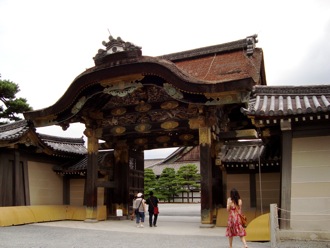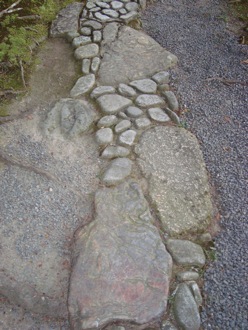I started by visiting the gardens of Nijo-jo, the Kyoto castle of the Tokugawa shoguns. The gardens combined water and land elements with a lot of great rocks.
Then I walked over to the Shibori Museum. Shibori is a kind of tie-dying. It is extremely detailed and time-consuming. I was fascinated by the process and the beautiful fabric patterns created.
Next I walked through the Nishiki Food Market, where you can buy any kind of fish imaginable, as well as many other products.
I took a quick look at the largest electronics store in Kyoto – 6 floors. Didn’t see anything too surprising. However, I was struck by the fact that across the street was a traditional-looking temple. This integration between traditional and “modern” elements was a pattern I saw over and over again.
In the afternoon, I visited my final garden, at the former home of Hashimoto Kansetsu, a painter from the early 1900s. The garden is known as Hakusa Sonso. It is near Ginkakuji. I am so grateful to Steven Saute for this find – it was not listed in any guidebook, only in the materials that Steve emailed me!
This garden was constructed on a more personal scale than the temple gardens. But you could see that the painter had put a lot of time and effort into it. It had two ponds, a tiny creek, plantings, and lots of stone statuary. In particular, there was a whole forest of little stone Buddha statues on one hillside. This garden showed a sense of humor!
The garden seemed to be suffering neglect – I could see places where plants needed to be trimmed, and one of the ponds had been allowed to dry out. Sad.
The painter’s house contained a small museum, the best part of which was a video of the painter playing on a TV. There was no sound and the film was clearly old, maybe from the 1920s? The first thing I saw was a bunch of huge dogs, maybe Dobermans, jumping on Kansetsu and licking his face. When they put their paws on his shoulders, they were taller than him! They kept almost knocking him down in the enthusiasm of their affection. He stood there with a smile on his face, looking slightly embarrassed. It was so cute and funny! Then in the next scene, Kansetsu was painting a picture of a monkey. There was a small image of a monkey clipped to the drawing board. So at first I thought, oh, he is painting from a photograph. Then the camera angle widened, and you could see a bunch of monkeys hanging all over the studio. So funny! Clearly the man loved animals. Apparently his animal pictures were considered especially excellent. I got a postcard of a monkey picture.










